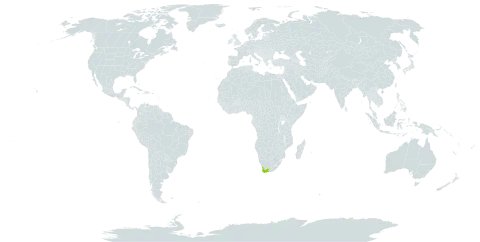An erect branching shrublet; branches erecto-patent-ascending, slender, distinctly white-or greyish-woolly when young, leafy in the upper parts; older branches nude and glabrate; cortex greyish-reddish brown. Leaves laxly to moderately closely set, erecto-patent-spreading, linear-filiform, 1.5-3.5 cm long, c. 1 mm wide, flexuous, completely entire, subterete-somewhat flattened, coriaceous, somewhat rugulose when dry, with a minutely colliculate surface, adaxially finely impressed-midveined, distinctly acuminate-mucronate, esp. when young. Peduncles lateral in the upper leaf-axils, erect or ascending, flexuous, up to 10 on each branch, long and slender, 5-16 cm long, c. 0.5 mm thick or less, somewhat thickened below the involucre, glabrous, terete, faintly striate. Involucre hemispherical-broadly and flatly cupshaped, 0.8-1.2 cm in diam. Involucral bracts 12-15, uniseriate, connate to c. 2/5, lanceolate, 5-6 mm long and c. 1 mm wide, coriaceous, glabrous, brown, indistinctly 1-3-veined, acute, with smooth margins and puberulous tips. Receptacle distinctly conical, alveolate. Ray-florets 13-18, yellow with a reddish tinge (at least when dry). Tube 0.7-1 mm long, basally inflated, at length conical. Lamina lorate or narrowly oblong, 6-8 mm long, 1.5-2 mm wide, 4-veined. Style terete with swollen base on a distinct stylophore; style branches 0.2-0.5 mm long, truncate-obtuse. Disc-florets c. 50-60. Corolla 2-2.5 mm long. Tube 0.7-1 mm long, cylindrical with inflated base. Limb campanulate, 1.2-1.5 mm long, lobed to the middle; lobes narrowly triangular with cucullate tips. Anthers 0.7-1 mm long incl. the ovate obtuse appendage. Style terete or somewhat flattened with swollen base; stylophore distinct; style branches 0.2-0.4 mm long, with convex-truncate tips, sometimes sterile. Pappus bristles numerous, 1-1.5 mm long, very shortly barbellate, flexuous, white. Achenes narrowly oblong, terete, sometimes slightly curved, c. 2 mm long and 3/4 mm wide, glabrous, glossy brown and often rufescent, contracted below the annulus-shaped top, with a distinct apical appendage (= persistent stylophore), with 10 close-lying, smooth, convex ribs; apical appendage oblong, cylindrical, truncate, c. 0.5 mm long, white or whitish.
More
Slender, white-woolly shrublet to 10 cm. Leaves linear-filiform, acuminate, loosely twisted, 15-35 mm long. Flower heads radiate, solitary on elongate peduncles, yellow.
